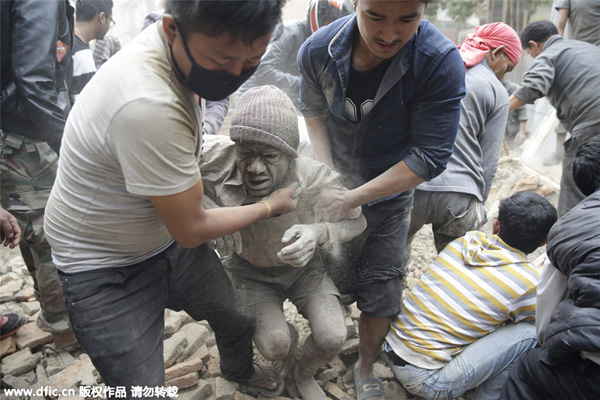Devastating Nepal quake kills 1,457
(Agencies/chinadaily.com.cn) Updated: 2015-04-26 01:38
 |
|
People free a man from the rubble of a destroyed building after an earthquake in Kathmandu, Nepal, April 25, 2015. [Photo/IC] |
KATHMANDU - A powerful earthquake struck Nepal on Saturday, killing 1,457 people, toppling a 19th-century tower in the capital Kathmandu and touching off a deadly avalanche on Mount Qomolangma, also known as Everest in the West.
There were reports of devastation in outlying, isolated mountainous areas after the midday quake of magnitude 8.1, Nepal's worst in 81 years, centred 80 km east of the second city, Pokhara.
As fears grew of a humanitarian disaster in the impoverished Himalayan nation of 28 million, an overwhelmed government appealed for foreign help.
A 68-strong China International Search & Rescue Team (CISAR) will leave for Nepal at 6 am Sunday Beijing time on Saturday. The team, taking a chartered plane, will arrive in Katmandu midday Sunday, the China Earthquake Administration announced.
A police official said the death toll in Nepal alone had reached 1,130, more than half of them in the Kathmandu Valley.
A total of 13 residents in Southwest China's Tibet autonomous region are dead, including six from Gyirong county and seven from Nyalam county.
The electricity in Gyirong is out. And nearly 70% of Nyalam's buildings are damaged or have collapsed.
The quake was more destructive for being shallow, toppling buildings, opening gaping cracks in roads and sending people scurrying into the open as aftershocks rattled their damaged homes.
Indian tourist Devyani Pant was in a Kathmandu coffee shop with friends when "suddenly the tables started trembling and paintings on the wall fell on the ground."
"I screamed and rushed outside," she said by telephone from the capital, where at least 300 people died.
"We are now collecting bodies and rushing the injured to the ambulance. We are being forced to pile several bodies one above the other to fit them in."
An Indian army mountaineering team found 18 bodies on Mount Qomolangma, where an avalanche unleashed by the earthquake swept through the base camp, where more than 1,000 climbers had gathered at the start of the climbing season.






